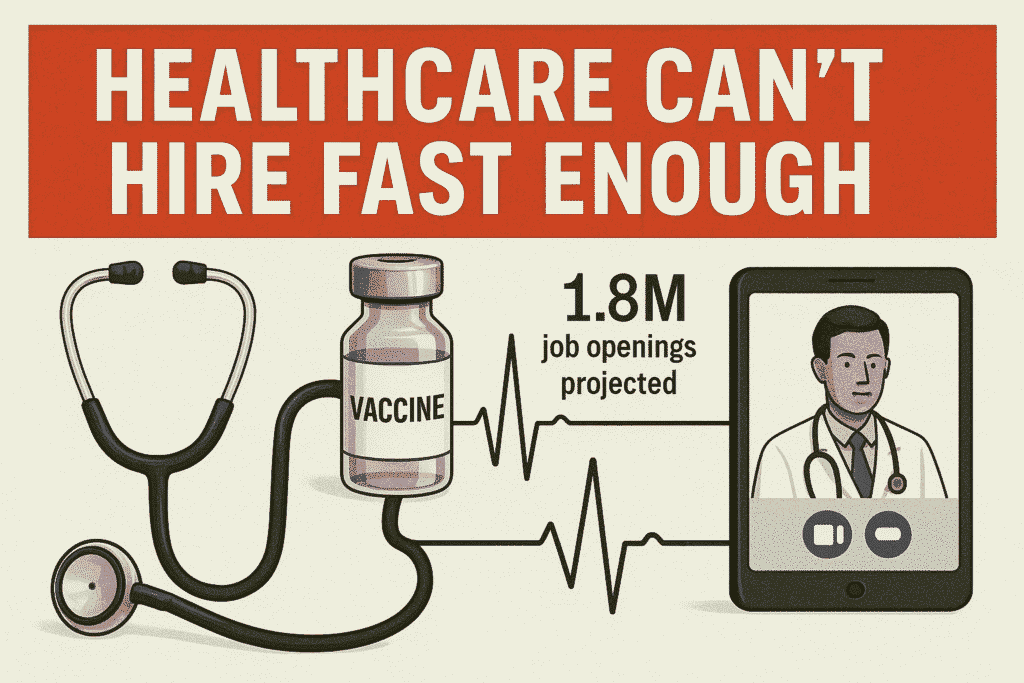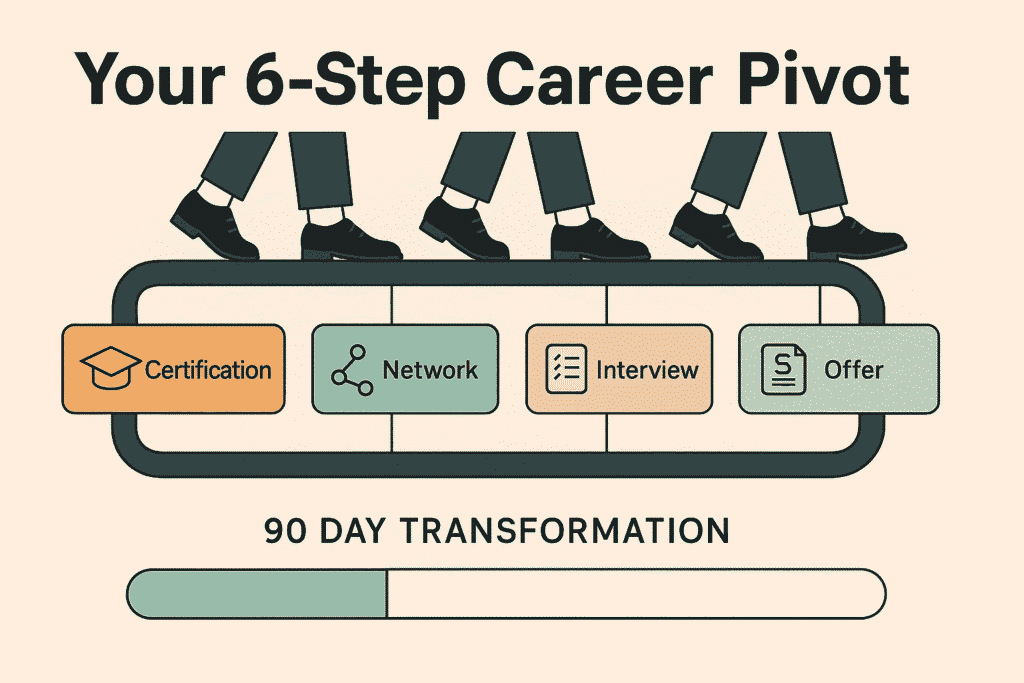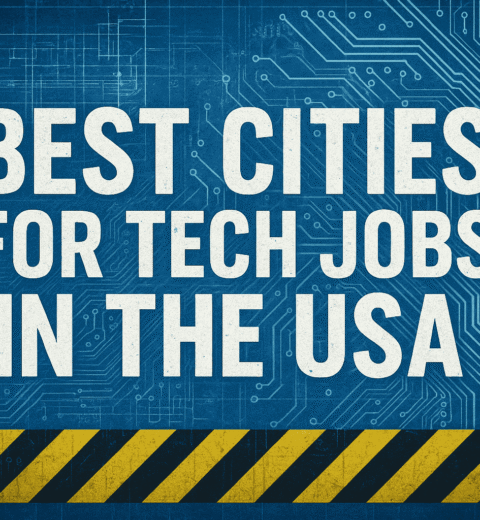Table of Contents
- Introduction
- Current Job Market Trends in the USA
- Top Industries Hiring the Most in the USA
- Healthcare
- Technology & IT
- Construction & Skilled Trades
- Logistics & Transportation
- Finance & Insurance
- Renewable Energy & Sustainability
- Retail & E-Commerce
- Education & Training
- Emerging Sectors with High Hiring Demand
- How to Secure a Job in High-Demand Industries
- Conclusion
Introduction
The American job market is undergoing a remarkable transformation, shaped by technological innovation, changing demographics, and evolving economic priorities. As we move deeper into 2024, certain industries are surging ahead, creating a wealth of opportunities for job seekers across all experience levels. Whether you’re a fresh graduate taking your first steps into the professional world, a mid-career professional seeking a change, or a skilled worker looking to maximize your earning potential, understanding these dynamic job market trends is crucial for making smart career decisions.
What makes today’s employment landscape particularly exciting is how fundamentally it differs from just a few years ago. The post-pandemic economy has accelerated certain trends while creating entirely new ones. Remote work options have become standard in many sectors, artificial intelligence is reshaping job requirements, and sustainability initiatives are creating whole new categories of employment. At the same time, traditional sectors like healthcare and skilled trades continue to experience critical shortages, offering exceptional job security and competitive compensation.
This comprehensive guide will take you through the industries currently driving employment growth in the United States. We’ll explore not just which fields are hiring, but why they’re expanding, what types of positions are most in demand, and how you can position yourself to take advantage of these opportunities. From the ongoing tech revolution to the renewable energy boom, from healthcare’s relentless growth to the resurgence of manufacturing, we’ll provide the insights you need to navigate today’s job market with confidence.
Understanding these trends is about more than just finding any job—it’s about identifying where the best long-term opportunities lie, which skills will remain valuable in the coming decade, and how to align your career path with sectors that offer both stability and growth potential. Whether you’re looking for immediate employment or planning your next career move, this analysis of the current hiring landscape will give you the knowledge to make informed decisions about your professional future in an ever-changing economy.
The American workforce is at an interesting crossroads, with traditional employment models blending with innovative new approaches. As automation handles more routine tasks, human skills like creativity, emotional intelligence, and complex problem-solving are becoming increasingly valuable. Meanwhile, the push for sustainability is creating entirely new career paths that didn’t exist a generation ago. This guide will help you cut through the noise and focus on the sectors where your skills and ambitions can find the most rewarding opportunities in today’s dynamic job market.
Current Job Market Trends in the USA
As we navigate through 2024, the U.S. job market presents a fascinating landscape of recovery and transformation. The post-pandemic economic rebound has brought unemployment rates down to stable levels but created an unexpected paradox: while jobs are plentiful across many sectors, employers in numerous industries are struggling to fill positions due to ongoing labor shortages. This unique situation creates exceptional opportunities for job seekers who understand where and how to position themselves in today’s evolving employment market.
The widespread acceptance of flexible work schedules has been one of the biggest changes. What began as a temporary pandemic measure has blossomed into a fundamental restructuring of work culture. Technology, finance, and customer service sectors in particular have embraced remote and hybrid models, with many companies now offering these options as standard benefits rather than temporary concessions. This transformation has opened up new possibilities for workers seeking better work-life balance and geographic flexibility while simultaneously forcing employers to rethink their recruitment strategies to attract top talent in a more competitive environment.
The rapid advancement of automation and artificial intelligence continues to reshape the employment landscape in profound ways. While fears of job displacement persist, the reality is more nuanced. Yes, certain routine tasks are being automated, but this technological revolution is simultaneously creating exciting new career paths. Positions in AI management, machine learning operations, and data analysis are emerging faster than educational institutions can train professionals to fill them. Workers who can bridge the gap between technical systems and human needs are finding themselves in particularly high demand.
Demographic changes are creating another powerful undercurrent in today’s job market. The retirement of baby boomers is leaving significant gaps in crucial sectors, particularly healthcare and skilled trades. Hospitals, clinics, and medical facilities across the nation report persistent staffing shortages, while trades like electrical work, plumbing, and HVAC installation struggle to attract enough new workers to replace those leaving the workforce. These shortages translate into excellent job security and rising wages for those entering these fields.
Perhaps one of the most promising developments is the explosive growth of green economy jobs. Government incentives and corporate sustainability initiatives are driving unprecedented expansion in renewable energy and environmental sectors. Solar panel installation, wind turbine maintenance, energy efficiency consulting, and sustainable construction are just a few of the areas experiencing rapid job creation. This trend shows no signs of slowing as climate concerns and energy independence remain national priorities.
For today’s job seekers, understanding these trends isn’t just helpful—it’s essential for making informed career decisions. The market rewards those who can align their skills with these emerging opportunities while remaining adaptable to ongoing changes. Whether you’re considering a career change, re-entering the workforce, or just starting your professional journey, recognizing these patterns can help you identify where your talents might be most valued in our evolving economy. The current job market offers remarkable possibilities for those willing to develop the right skills and position themselves strategically in these growing sectors.
Top Industries Hiring the Most in the USA
Healthcare

The healthcare industry continues to stand as America’s most recession-proof and fastest-growing employment sector, with no signs of slowing down. What makes healthcare uniquely positioned for sustained growth? A perfect storm of demographic changes, technological advancements, and evolving patient needs has created an unprecedented demand for medical professionals at all levels.
At the heart of this expansion lies America’s aging population. As baby boomers enter their retirement years, they’re requiring more medical attention than any previous generation. This silver tsunami has created critical staffing shortages across the entire healthcare spectrum. Registered nurses find themselves in particularly high demand, with hospitals offering signing bonuses and tuition reimbursement to attract talent. Physicians and surgeons specializing in geriatric care are seeing their waiting rooms fill faster than they can accommodate patients.
The rise of chronic health conditions represents another major driver of healthcare employment. With diabetes, heart disease, and obesity reaching epidemic proportions, medical facilities need more professionals to manage these long-term conditions. Pharmacists play an increasingly vital role in medication management, while medical assistants help overwhelmed practitioners handle the growing patient load.
Technology is transforming healthcare delivery in ways that create new job opportunities. The explosive growth of telehealth services has spawned demand for tech-savvy healthcare professionals who can provide remote consultations. Home health aides are becoming essential as more patients opt for recovery and treatment in their homes rather than hospitals. These positions offer rewarding career paths without requiring advanced medical degrees.
For international professionals, the U.S. healthcare sector presents particularly attractive opportunities. Many hospitals and healthcare systems actively recruit foreign-trained nurses, doctors, and specialists, often offering visa sponsorship to fill critical staffing gaps. The combination of competitive salaries, strong job security, and the chance to work with cutting-edge medical technology makes healthcare one of the most accessible pathways for skilled immigrants seeking employment in America.
What makes healthcare careers especially appealing is their diversity. From hands-on patient care to behind-the-scenes technical roles, from urban hospital settings to rural clinics, the sector offers something for nearly every skillset and interest. Whether you’re drawn to the fast-paced environment of emergency medicine or prefer the steady rhythm of a family practice, whether you want to work directly with patients or focus on medical technology, healthcare provides stable, meaningful employment opportunities that simply can’t be outsourced or automated away.
The industry’s growth shows every indication of continuing for decades to come, making healthcare one of the smartest career bets in today’s job market. For those considering this path, now is an ideal time to acquire the necessary qualifications and position yourself for a rewarding career that makes a real difference in people’s lives while offering exceptional job security.
The growing nurse shortage has led many hospitals to actively recruit internationally trained professionals, with numerous healthcare jobs with visa sponsorship available for qualified candidates.
Technology & IT

America’s technology sector is experiencing an unprecedented hiring boom that’s reshaping the entire employment landscape. What was once a niche industry has become the driving force behind job creation across all sectors, as digital transformation sweeps through every corner of the economy. From Silicon Valley giants to Main Street businesses adopting new technologies, the demand for tech talent has never been higher.
Software engineers remain the rock stars of this digital revolution, with companies competing fiercely for top coding talent. But it’s not just traditional programming roles that are in demand. The explosion of big data has created a gold rush for data scientists who can turn raw information into business insights. These modern-day alchemists command premium salaries as they help organizations make data-driven decisions in everything from healthcare to retail.
One of the most important and rapidly expanding specialties is cybersecurity. With cyberattacks becoming more sophisticated and frequent, organizations are scrambling to protect their digital assets. Cybersecurity analysts find themselves on the front lines of this invisible war, with job openings outpacing qualified candidates by nearly 3-to-1 in some markets. The stakes couldn’t be higher—a single breach can cost companies millions and damage reputations overnight.
Perhaps no area exemplifies the future of tech employment more than artificial intelligence and machine learning. As businesses race to implement AI solutions, specialists who can develop, train, and maintain these systems are seeing their value skyrocket. From chatbots to predictive analytics, AI is creating entirely new categories of employment that didn’t exist five years ago.
The cloud computing revolution continues to generate tremendous opportunities as well. Cloud architects who can design and manage complex cloud infrastructures are particularly sought after as companies migrate from traditional servers to more flexible, scalable solutions. This shift has created ripple effects across IT departments, with demand for professionals skilled in platforms like AWS, Azure, and Google Cloud.
What makes the tech job market especially exciting is its democratization. While many positions still require advanced degrees, alternative pathways like coding bootcamps and certification programs have opened doors for career changers. The industry’s rapid evolution means that motivated individuals can often acquire in-demand skills relatively quickly compared to more traditional professions.
For job seekers, the technology sector offers unparalleled opportunities for growth, creativity, and compensation. Unlike some industries where automation threatens jobs, tech professionals are typically the ones building the automation tools, making their skills increasingly valuable in our digital-first economy. The IT sector offers a multitude of fulfilling career options with great long-term prospects, regardless of your preference for the creative problem-solving of software development, the intellectual challenge of data science, or the mission-critical nature of cybersecurity.
Construction & Skilled Trades

While headlines often focus on tech and healthcare jobs, a quiet revolution is happening in America’s construction and skilled trades sector. These hands-on careers are experiencing a renaissance, offering six-figure earning potential without requiring a four-year degree. The current demand for trade professionals isn’t just a temporary spike—it represents a fundamental shift in our economy that’s creating generational opportunities for skilled workers.
The construction industry is firing on all cylinders thanks to two powerful economic forces. First, the Biden administration’s $1.2 trillion Infrastructure Investment and Jobs Act is pouring billions into rebuilding America’s roads, bridges, and utilities. Second, the nationwide housing shortage has sparked a construction frenzy, with developers scrambling to build homes as fast as possible. These twin drivers have created an unprecedented need for skilled tradespeople that shows no signs of slowing down.
Electricians are at the forefront of this boom, with their expertise needed for everything from wiring new smart homes to upgrading the nation’s aging electrical grid. Modern plumbers aren’t just fixing leaks—they’re installing high-efficiency water systems in commercial buildings and retrofitting homes with eco-friendly fixtures. HVAC technicians have become some of the most sought-after professionals as climate change increases demand for heating and cooling solutions, particularly energy-efficient systems that meet new environmental standards.
The welding profession offers particularly exciting opportunities, with specialized welders commanding premium pay in industries ranging from automotive manufacturing to renewable energy projects. Meanwhile, construction managers are enjoying rapid career advancement as they oversee complex projects from groundbreaking to completion. Many trade professionals are discovering they can earn more than college graduates while avoiding student debt—with some master tradespeople pulling in $100,000+ annually after just a few years in the field.
What makes today’s trades careers different from previous generations is the technology integration. Modern construction sites use drones for surveying, 3D printing for components, and augmented reality for planning. Skilled workers who can combine traditional craftsmanship with these new technologies are positioning themselves for the highest-paying opportunities.
The industry faces a critical shortage as experienced tradespeople retire without enough young workers entering the field. This supply-demand imbalance has created a golden age for trade professionals, with companies offering signing bonuses, accelerated training programs, and benefits packages that rival corporate jobs. For hands-on learners who enjoy seeing the tangible results of their work, there’s never been a better time to pursue a skilled trade career.
For readers interested in exploring these opportunities, our guide to high-paying skilled trade jobs provides detailed salary information, training requirements, and tips for launching your career in this thriving sector.
Electricians and welders are now ranking among the highest-paying skilled worker jobs, with overtime often pushing earnings into six figures.
Logistics & Transportation

Beneath the surface of every “Buy Now” button lies a complex network of logistics professionals keeping goods moving across the country. The explosive growth of e-commerce has transformed logistics and transportation into one of America’s most vital and fastest-growing employment sectors. What was once an invisible backbone of commerce has emerged as a dynamic field offering diverse career paths with competitive wages and surprising advancement opportunities.
The digital shopping revolution shows no signs of slowing, with consumers now expecting everything from groceries to furniture to arrive at their doorstep within days—sometimes hours. This cultural shift has created an insatiable demand for truck drivers, who form the critical link in the supply chain. Modern trucking offers far more than just long-haul routes; specialized drivers for refrigerated goods, hazardous materials, and oversized loads command premium pay. The industry is actively recruiting younger drivers and women to replace retiring Baby Boomers, with many companies offering paid training programs.
Inside sprawling fulfillment centers across the country, warehouse operations have evolved into high-tech environments where workers collaborate with robotics and AI systems. Today’s warehouse associates aren’t just moving boxes—they’re operating advanced inventory systems, troubleshooting automated equipment, and managing complex sorting operations. These tech-enhanced facilities offer climate-controlled work environments and career ladders that can lead to supervisory roles within months.
The delivery driver shortage has become particularly acute as consumers grow accustomed to same-day service. What began as a niche service for takeout meals has expanded to include everything from pharmacy prescriptions to luxury goods. Delivery professionals now enjoy flexible scheduling options, with many platforms allowing workers to choose their hours while earning performance bonuses.
Behind the scenes, supply chain managers have become the unsung heroes of the post-pandemic economy. These logistics professionals combine analytical skills with practical knowledge to optimize routes, manage inventory flows, and solve complex distribution challenges. With companies prioritizing resilient supply chains, these roles offer stability and growth potential even during economic downturns.
The industry is responding to labor challenges with significant wage increases, improved benefits packages, and better working conditions. Many logistics companies now offer tuition reimbursement, recognizing that today’s warehouse worker could be tomorrow’s operations manager. For job seekers who enjoy problem-solving, variety in their workday, and seeing tangible results from their efforts, logistics and transportation offer rewarding careers that keep America moving forward.
Finance & Insurance

Beneath the headlines about cryptocurrency and digital wallets, America’s traditional finance and insurance sector is undergoing a quiet transformation that’s creating exceptional career opportunities. As the financial world evolves to meet digital-age demands, professionals who can bridge the gap between established practices and emerging technologies are finding themselves in the driver’s seat of their careers.
Financial analysts are experiencing a golden age of opportunity as businesses of all sizes seek guidance in navigating economic uncertainty. These number-savvy professionals are no longer confined to Wall Street—they’re helping mid-sized manufacturers optimize operations, guiding tech startups through funding rounds, and assisting families with college savings strategies. The proliferation of data analytics tools has elevated their role from number crunchers to strategic advisors who can spot trends before they emerge.
The accounting profession, often stereotyped as dull, has become surprisingly dynamic. Modern accountants serve as financial detectives, compliance experts, and business consultants rolled into one. With tax laws growing increasingly complex and new reporting requirements emerging constantly, businesses are willing to pay top dollar for accounting professionals who can help them avoid costly mistakes. People with experience in sustainability reporting or international taxation are especially in demand.
Insurance underwriting has transformed from a paperwork-heavy job to a data-driven profession where predictive modeling meets human judgment. Today’s underwriters use sophisticated algorithms alongside their industry experience to assess risks ranging from cyber threats to climate-related disasters. The profession offers surprising variety—one day evaluating a tech startup’s liability exposure, the next analyzing flood risks for coastal properties.
Fintech developers represent the new frontier of financial careers, building the apps and platforms reshaping how we manage money. These hybrid professionals combine financial acumen with coding skills to create solutions for mobile banking, automated investing, and fraud detection. Unlike traditional tech jobs, fintech roles require understanding complex regulations while innovating—a challenging combination that commands premium salaries.
Three powerful forces are driving this sector’s growth:
- The regulatory landscape grows more complex by the year, requiring experts to help businesses comply.
- Digital banking has moved from novelty to necessity, creating demand for professionals who understand both finance and technology.
- To manage retirement, an aging population requires advanced financial planning services.
For job seekers, this sector offers something increasingly rare—careers that combine the stability of established industries with the excitement of technological transformation. Whether you’re drawn to the analytical rigor of financial analysis, the problem-solving nature of accounting, the risk-assessment challenges of underwriting, or the innovative potential of fintech development, financial services provide rewarding career paths with excellent long-term prospects.
Emerging Sectors with High Hiring Demand
Renewable Energy & Sustainability

As America transitions toward clean energy, renewable energy and sustainability careers are experiencing explosive growth unlike any other sector. These aren’t just jobs of the future—they’re high-demand opportunities available right now, offering competitive salaries and the chance to be part of solving humanity’s greatest challenge.
Solar panel installers have become the face of this green jobs boom, with rooftops across America transforming into power generators. These skilled technicians combine construction knowledge with electrical expertise, working outdoors to install increasingly efficient photovoltaic systems. The role offers immediate entry points for those willing to train, with clear pathways to becoming crew supervisors or starting independent contracting businesses.
One of the occupations in the energy industry with the quickest rate of growth is wind turbine technician. From offshore wind farms to the Great Plains, these “wind farmers” are responsible for the tall turbines that adorn the landscape. The job combines mechanical skills with computer diagnostics, often requiring technicians to work hundreds of feet in the air. With major investments in offshore wind projects along both coasts, these careers offer geographic flexibility and strong union benefits in many markets.
Environmental engineers serve as the master planners of sustainability initiatives. They’re designing everything from zero-waste manufacturing processes to urban stormwater systems that mimic natural ecosystems. Modern environmental engineering blends traditional civil engineering principles with cutting-edge sustainable design, creating solutions that benefit both businesses and communities. Professionals in this field frequently collaborate with architects, urban planners, and policymakers.
The sector’s rapid expansion stems from powerful economic and policy forces. The largest climate investment in the United States is represented by the Inflation Reduction Act. history, pouring billions into clean energy projects that require skilled workers. Simultaneously, corporate America has embraced sustainability not just as good PR but as good business—companies are competing to reduce carbon footprints and energy costs.
What makes these careers particularly rewarding is their mission-driven nature. Workers in renewable energy and sustainability can see the tangible impact of their labor—whether it’s watching a solar array power a neighborhood, maintaining turbines that provide clean electricity to thousands, or designing systems that reduce environmental harm. The sector offers something increasingly rare in the job market: financial stability combined with personal fulfillment.
For job seekers, this represents a generational opportunity to build careers that will remain relevant for decades. The transition to clean energy isn’t a temporary trend—it’s a fundamental restructuring of our economy that will require skilled workers at all levels. Whether you’re drawn to hands-on technical work, engineering challenges, or sustainability planning, the green economy offers diverse pathways to meaningful, well-compensated careers.
Retail & E-Commerce

While headlines often declare the “death of retail,” the industry is actually undergoing a remarkable transformation that’s creating exciting new career opportunities. Today’s retail and e-commerce jobs look dramatically different than they did just five years ago, blending technology with human touch in ways that are proving automation-resistant and increasingly rewarding.
E-commerce specialists have become the architects of digital storefronts that never close. These professionals do much more than manage product listings—they optimize the entire online shopping experience through data analysis, user experience testing, and conversion rate optimization. A talented e-commerce specialist might spend their morning analyzing customer behavior patterns, their afternoon coordinating with graphic designers on product imagery, and their evening A/B testing different checkout flows. Brands are investing heavily in these roles as online sales become their primary revenue channel.
Customer service representatives have evolved from script readers to brand ambassadors who solve complex problems across multiple digital platforms. Modern customer service blends emotional intelligence with technical skills, as representatives might handle a live chat, troubleshoot an app issue, and de-escalate a frustrated customer—all within the same hour. Companies are increasingly valuing these roles as differentiators in competitive markets, leading to better training programs and career advancement opportunities.
Digital marketing experts in retail are playing a high-stakes game of data-driven creativity. They’re not just running ads—they’re building entire customer journeys that begin with social media engagement and culminate in personalized post-purchase experiences. The most sought-after professionals combine analytical skills with creative flair, using tools like AI-powered recommendation engines and predictive analytics to deliver the right message to the right customer at the perfect moment.
Two powerful forces are driving this sector’s resilience:
- The permanent shift to omnichannel shopping has made digital retail expertise indispensable.
- Consumers increasingly demand personalized experiences that blend the convenience of technology with human understanding.
What makes these careers particularly appealing is their accessibility. Many roles value demonstrated skills over formal education, with portfolio projects and certifications often carrying as much weight as degrees. The field also offers remarkable flexibility, with opportunities ranging from corporate positions at major retailers to freelance consulting for boutique brands.
For those who enjoy solving puzzles, understanding people, and working in fast-paced environments, retail and e-commerce offer dynamic career paths where no two days are the same. As the line between physical and digital retail continues to blur, professionals who can navigate both worlds will find themselves at the forefront of an industry that’s constantly reinventing itself.
How to Secure a Job in High-Demand Industries

Breaking into high-demand fields requires more than just submitting applications—it demands a strategic approach tailored to each industry’s unique needs. Let’s explore proven methods to position yourself as a top candidate in competitive job markets.
The foundation of any successful career transition begins with targeted skill development. In technology sectors, certifications like AWS Cloud Practitioner or CompTIA Security+ can validate your expertise more effectively than generic degrees. Healthcare hopefuls should research state-specific licensing requirements—for instance, an accelerated nursing program might be the golden ticket for career changers. Many trade unions now offer earn-while-you-learn apprenticeships that combine hands-on training with immediate income. The key is identifying which credentials carry the most weight in your target field and pursuing them through reputable programs.
In today’s job market, establishing professional ties is more important than ever. Platforms like LinkedIn have evolved beyond digital resumes into vibrant professional communities where hiring managers actively seek talent. Try commenting thoughtfully on industry leaders’ posts before sending connection requests to establish credibility. Local meetups and conferences offer invaluable face-to-face networking—arrive early to trade shows to catch speakers when they’re more accessible. Remember that networking is about mutual benefit; consider what insights or assistance you can offer contacts rather than just asking for favors.
Your resume needs to tell a compelling story about why you’re perfect for this specific role. Generic applications get lost in applicant tracking systems—study job descriptions to identify keywords and mirror their language. A construction manager applicant might highlight “OSHA compliance” and “lean construction principles,” while a healthcare candidate should emphasize “patient-centered care” and “EMR proficiency.” Quantify achievements wherever possible. “Increased warehouse efficiency by 18% through process redesign” lands better than “responsible for operations improvement.”
Geographic flexibility can dramatically expand your opportunities. Energy sector jobs cluster in Texas and the Gulf Coast, while tech hubs like Austin and Raleigh hunger for talent. The Midwest faces acute shortages in healthcare and skilled trades, often offering relocation bonuses. Research emerging secondary markets—cities like Nashville and Salt Lake City are building thriving tech scenes with lower competition than Silicon Valley. If moving isn’t feasible, explore remote opportunities in fields like IT support, medical coding, or digital marketing.
The job search process itself requires customization. Set up Google alerts for your target companies to catch openings early. To view employee posts that may highlight unmet needs, follow companies on LinkedIn. For trades, physically visiting local union halls or contractors’ offices can make stronger impressions than online applications. In healthcare, per-diem or registry positions often serve as gateways to full-time roles.
Remember that career transitions are marathons, not sprints. One teacher-turned-software developer documented her 18-month upskilling journey in a blog that ultimately caught a recruiter’s attention. A former retail manager leveraged transferable customer service skills to break into pharmaceutical sales through temporary work. Your unique background brings valuable perspective—the trick is framing it as an asset rather than an obstacle in your target field.
By combining strategic preparation with persistent, tailored outreach, you can position yourself for success in even the most competitive, high-demand industries. The opportunities exist—now it’s about developing the right roadmap to claim yours.
Conclusion

As we’ve explored, the American job market in 2024 presents a landscape rich with opportunity for those who know where to look. The healthcare sector continues its steady expansion, offering both clinical roles and behind-the-scenes positions that keep our medical system running. Careers in technology are developing at a breakneck pace, giving rise to fascinating new specialties at the nexus of invention and real-world application. The construction and skilled trades industry is experiencing a renaissance, where traditional craftsmanship meets cutting-edge techniques. Meanwhile, renewable energy has emerged as more than just a niche—it’s becoming the backbone of our national infrastructure.
What makes this moment particularly special for job seekers is the convergence of several powerful trends. Employers across these sectors aren’t just hiring—they’re actively competing for talent, offering better compensation packages, flexible arrangements, and clearer paths for advancement than we’ve seen in decades. The key to capitalizing on this environment lies in thoughtful preparation: understanding which skills are most valued in your target industry, positioning your existing experience strategically, and being open to unconventional entry points that can lead to rewarding long-term careers.
For those willing to invest in their professional development, the payoff can be substantial. Consider the electrician who specializes in solar installations, the nurse who develops telehealth expertise, or the IT professional who bridges traditional systems with AI applications—these are the professionals commanding top salaries and enjoying exceptional job security in today’s market.
As you contemplate your next career move, remember that resources are available to help you navigate these opportunities. Whether you’re exploring healthcare careers with visa sponsorship options or investigating high-paying skilled trade positions, the first step is simply arming yourself with knowledge about where the opportunities lie and what it takes to qualify.
For the first time in many generations, the American workforce is changing dramatically. By aligning your ambitions with these growing sectors, you’re not just finding a job—you’re building a future-proof career in industries that will shape our economy for decades to come. The opportunities are there for the taking; now is the time to prepare, position yourself, and pursue the career you deserve.
International medical professionals should explore these U.S. healthcare visa opportunities as demand continues to outpace domestic supply.




